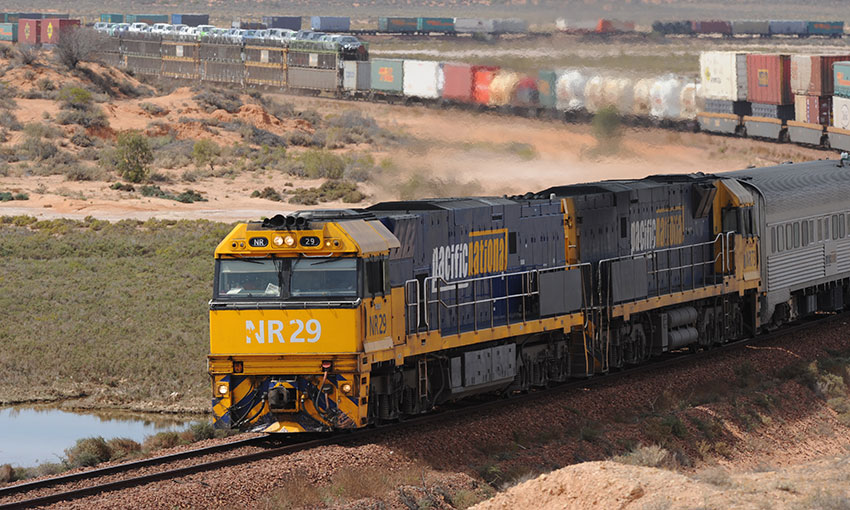RAIL freight company Pacific National is today (13 December) unveiling plans to develop a new intermodal rail terminal at Little River, Victoria. The terminal is to connect to Inland Rail.
The company aims to have the 80-hectare intermodal terminal – featuring warehousing, cold storage and refuelling facilities – operational by 2026.
Pacific National CEO Paul Scurrah said the company had secured an option over a large 540-hectare site to build the terminal and develop a surrounding logistics precinct on the existing interstate rail corridor west of Melbourne’s CBD and port.
“Pacific National’s new Little River site is in a prime position on the main interstate rail line and close to the Princes Freeway, delivering efficient freight transport connectivity to nearby logistics companies, distribution centres, warehouses, shippers, and manufacturers,” he said.
“Close to Melbourne’s freight centre of gravity, Pacific National’s plans for Little River will help to shift more freight from road to rail until delivery of the Western Interstate Freight Terminal.”
Pacific National’s Little River site is located near Melbourne’s major freight catchment zone to the west of the CBD. Here, the company says, more than 70% of containerised rail volumes are concentrated. It is 39 kilometres by rail to the Port of Melbourne.
Mr Scurrah said a Little River terminal would better service the major east-west market – a critical corridor in the national supply chain – where approximately three million tonnes of containerised freight is hauled annually by rail from Melbourne, to Adelaide, and then across the Nullarbor to Perth.
“Pacific National is investing heavily in an extensive national terminal strategy in response to surging customer demand for containerised interstate rail freight services,” he said.
“The coronavirus pandemic accelerated the trend towards online shopping and created disruptions and delays in road and shipping operations, creating greater demand for rail freight services.”
Inland rail strategy
Mr Scurrah said Pacific National is securing key sites along the Inland Rail alignment to unlock benefits of the project and haul greater containerised volumes by rail not only between Melbourne and Brisbane but also from Australia’s east coast to Western Australia.
In recent years, Pacific National has invested $35 million to deliver regional Australia’s largest intermodal terminal at Parkes in the Central West of New South Wales and secured Acacia Ridge Terminal in South East Queensland via a $205 million acquisition – both are located on the alignment of the future Melbourne-Brisbane Inland Rail.
Mr Scurrah said several government-sponsored studies confirmed the best location for a major Victorian interstate rail terminal was west of Melbourne’s CBD and port, in Truganina, rather than to the north.
“Unfortunately delays and funding blocks in progressing the WIFT option, including the proposed enabling infrastructure called the Outer Metropolitan Ring transport corridor, mean a terminal cannot be delivered in time to meet industry needs and ahead of completion of the Inland Rail in 2027,” he said.
Better than Beveridge?
Mr Scurrah said a proposed terminal at Beveridge 55 kilometres north of Melbourne’s CBD and port would derail government plans to shift more freight from trucks to trains.
“Containers picked up by trucks and hauled from the port or a warehouse in Melbourne’s western freight zone will simply travel up the Hume Freeway (M31),” he said.
“It will always be cheaper for those large trucks loaded with freight to keep going, drive past the gates of a terminal in Beveridge and deliver their goods by road across the state border into NSW.”
Freight operator Qube has proposed developing about 1100 hectares of land into an intermodal freight rail terminal at Beveridge.
Western freight zone
Mr Scurrah said an intermodal container terminal in Little River will complement a future WIFT in Truganina – both helping to service Melbourne’s growing western freight zone.
“The $15-billion Inland Rail project is forecast to accelerate growth of container freight volumes on the interstate rail network to more than one million TEUs by 2035, making it critical for the Australian and Victorian governments to work closely together to deliver a future WIFT,” he said.
Pacific National said if a terminal was located north of Melbourne in Beveridge instead of west of the CBD and port it would mean:
- an additional 250,000 unnecessary truck trips on Melbourne’s road network a year by 2031, growing to more than 400,000 by 2050;
- an extra 900,000 additional truck kilometres on the nation’s interstate road network each day by 2031, growing to more than 1.5 million by 2050; and
- an additional 470,000 tonnes of carbon dioxide emissions by 2031, increasing to nearly 800,000 tonnes by 2050 due to extra trucks and loss of rail mode share.
Mr Scurrah said customers are on board with a Little River terminal as they increasingly understand and appreciate the safety and environmental benefits of hauling large volumes of freight by rail.
“By using our services, 400 Pacific National customers enjoy immediate and strong ESG performance metrics and credentials, including being part of freight services which help reduce traffic congestion, road accidents and fatalities, and vehicle emissions,” he said.
“Road freight produces 14 times greater accident costs than rail freight per tonne kilometre and up to 16 times more carbon pollution as rail freight per tonne kilometre.”





